#cecilie's travel adventures
Explore tagged Tumblr posts
Text
July 11, 2023
By Jonathan Taylor
(Los Angeles Times) — Jet-lagged and exhausted, LeVar Burton rallied his youthful energy as he exited customs at New York’s JFK airport and climbed into a waiting limo. He had just traveled from the Zambezi River in Zambia, where he had filmed a segment for the April 4, 1982, episode of ABC’s “The American Sportsman.”
The car made its way from Queens to Manhattan, dropping him off at Central Park. He was there to shoot the pilot for a new public television show aimed at encouraging early learners to love books.
The show was to be called “Reading Rainbow.”
He was not entirely sure what the job was, and certainly not aware that it would become one of his signature roles. It didn’t matter. The son of a former teacher and a passionate believer in learning, reading, exploring and growing, Burton was all-in on this new adventure.
“Everything about it just made sense,” Burton says, more than 40 years later. “It was about literature and the written word, it was about kids, it was about having kids discover the power of literature through the medium of television and that was why ‘Reading Rainbow’ was such a radical departure from other shows of its era.”
From the moment he first met the “Reading Rainbow”crew, Burton demonstrated not one iota of star attitude.
“He showed up, got out of the limo, and I said, ‘Hey, how are you?’” Cecily Truett, co-creator, head writer and producer on the show for most of its run, recalls. “He said, ‘Well, I just got off the red-eye, so…’ I said, ‘Well, what can we do for you? How can we make you comfortable?’ He said, ‘You know, I’d love to have a glass of orange juice and a toothbrush.’ And that was it.
“He walked right on to the set, he ran through his lines and for the next 25 years he was on the set, on time, with his lines memorized....”
“For 155 shows,” her husband, Larry Lancit, another of the show’s creators, producers and directors, added.
Burton had to hurry back from Africa to New York because a skeleton crew was waiting to shoot the pilot episode, including anxious documentarians Truett and Lancit and fellow creator and executive producer Twila C. Liggett, a onetime elementary school teacher who had realized TV was the ideal medium to reach and influence young children. If “Reading Rainbow” delivered on its promise that a children’s show focused on the joy and value of reading could be set in the real America rather than on Sesame Street or in Mister Rogers’ neighborhood, it would get the blessing from PBS.
It did the trick. This month marks the 40th anniversary of the national premiere of one of the longest-running children’s shows in the history of public television.
#Reading Rainbow#LeVar Burton#PBS#Corporation for Public Broadcasting#Ronald Reagan#George H.W. Bush#Bill Clinton#Los Angeles Times#huh the show was a co-production of Buffalo's and a Nebraska PBS station? did not know!#I swear too much of the programming is from WGBH or WNET - with apologies to any Bostonians and New Yorkers among you#but don't take my word for it#news
16 notes
·
View notes
Text
nobodies hero: the library keeper (book 1)
In the northern country of Omos, the ruling Prince Sasha has announced a quest. You see, there's a group of fanatics with a goal to bring dragons back from extinction (none have been seen in about a thousand years), and with rumours of one last dragon left hidden somewhere on the continent, the Prince is desperate to stop them.
He pleads for anyone to find this rumoured being before the so-called Flame Fanatics can, terrified that breaking this dragon free will cause it to unleash horror across the 4 countries.
Atlas, a young noble with a childhood dream of adventure, takes two of his friends - Cecily and her wife Ahria - and they set out to find anything that could lead them to where the dragon might be. Their search points them in one main direction: The Mahina Woods.
Infamously deadly, the Mahina Woods are an ancient stretch of forest trapped in perpetual night, and home to an even older race of warriors known as the Makai - owl shifters who walked the earth long before humans. It's a place of horrors and magic, often the setting of scary stories told at sleepovers or parent's warnings to be good or else-
It's said that no one who's entered has ever made it out.
Introducing Keika! a prickly librarian who wants nothing to do with adventures of any sort after leaving the Mahina Woods with his sister, Ahuru, when they were still children.
Atlas and his friends find Keika in a library in Arlet (a town that shouldn't exist) and Keika, begrudgingly, finds himself employed as a Guide.
He takes them to the Mahina Woods, where they meet with the Makai (and Keika is briefly reunited with his mum) and things begin to take a turn for Atlas and his friend's quest. See, the Makai are some of the oldest friends of the dragons, and offer a completely unique perspective on the history they were taught.
Armed with conflicting information, and sobering prophecies, Atlas and his companions part ways with Keika on the bank of the Mahina River. Supposedly, they will never cross paths again.
Until Keika gets back to Arlet and finds his sister dead and his town in ruins. Not knowing what else to do, and unable to stomach staying in the town where he and Ahuru built their lives - Keika leaves, and decides to join the others on their quest.
Along the months they travel together, following the Makai's leads and avoiding the flame fanatics, Keika and his new companions grow closer - he and Atlas especially, as they find themselves falling from friends to lovers.
(Keika, meanwhile, is trapped in a downwards spiral of unprocessed grief and the increasing burden of losing pieces of himself. He's doing great (lying).)
They locate the dragon's tomb in the heart of Miednic, and find themselves locked in a minor battle with the flame fanatics who managed to beat them there. Grievously injured, Atlas begs for Keika to finish the job on his behalf - an entirely selfish request that will haunt him for years after.
Keika, unable to deny his lover anything, takes the sword he's offered and steps - alone - into the dragon's tomb. It's the first time he takes a life with his own hands. The dragon kneels before him in the body of a young woman, older than him but still young, with exhausted eyes.
"Thank you." She says, as the sword swings. Thank you, his sister had said, the last time he saw her alive.
Believing Atlas to have died of his injuries, and his friends to have followed, Keika once again finds himself alone and burdened by a terrible grief. A burden he has not been able to set down for many months and is now only heavier.
Lost, alone, and exhausted Keika stands high above the Seline River and steps off the edge.
2 notes
·
View notes
Text
The Keepers • WIP Intro

WIP Intro - The Keepers
Genre: paranormal horror, romance, isolation horror, period action/adventure
Status: Zero drafting for NaNoWriMo 2023
Synopsis: A collector of occult items finds herself stranded on an island with a lighthouse and its keeper, and the ghosts of her past come back to haunt her.
Setting: Rocky shores somewhere off the coast of Oregon, 1938
Vibe: mist, gulls, rocky shores, candle wax against floorboards and window panes, loose parchment, ink-stained fingertips, the chill of breath against your neck, brine-bleached pant cuffs, the taste of charcoal and ash
Touchstones & Inspiration: Raiders of the Lost Ark, The Mummy, Pirates of the Caribbean, The Lighthouse, As Above So Below
Characters:
Mim - A headstrong and well-educated young woman who had her childhood stolen by grievers and grifters alike, mind now set to debunk the occult and acquire mystical and magical items if for no other reason than to prove the science (and often, coincidence) behind them. Often seen as a ‘tomboy��� or ‘unladylike’, Mim isn’t afraid to roll up her sleeves and get her hands dirty.
Buck - The keeper of a lighthouse, appointed decades, maybe centuries, before to ferry lost souls from one life onto the next. He’s set in his ways, resigned to the task gifted to him by whatever higher power, and grateful. He keeps to himself, only traveling off the island every month or so to restock his own supplies and to send trinkets back to the loved ones of those who had passed on.
Excerpt:
One such a thunderstorm, big lightning in the clouds and crocodile tears, moved Cecily’s birth into the barn. Ropers and ranchers, big men with bigger hands, all huddled around mama in her pile of hay, ready to catch knobby ankles and pull. Rain beat a steady rhythm against the ground, pooling dirt to mud, and Cecily bleated her woeful lament in tandem, big eyes bulging on either side of that wide, caramel forehead. Mim shushed, petting the patch of fur there, hoping it’d soothe the great, wide bovine while she struggled to birth what they all were sure to be twins. Laid out behind Mama Cow was a slender little calf, four legs, two ears, slowly blinking open two big, brown eyes. Black and white spots were dyed a deep purple-red like the mashing of grapes between toes, and the hay beneath the new baby clung to him like feathers to tar.
3 notes
·
View notes
Text
Silver Talks AniManga (25/06/23)
a new series and a finale today wao tho next week will be quite busy with 3 anime finales and 1 manga one and the 1 hour premier of the ryza anime let alone any stuff I might catch up to too since I'm on vacation from work, should be fun
blue - finale/completed green - new series/new to me
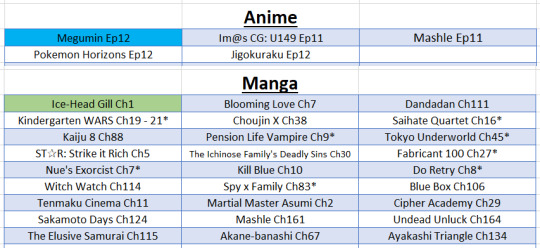
Anime
Megumin Ep12 (Finale)
I made a TLDR post about it the other day but the show is finally over. As I said a billion times since then, it should've ended after ep6, I felt like everything after that was very weak, especially ep9 when they were just cramming as many konosuba references as possible. As a disclaimer I don't like konosuba or find it funny, I find kazuma, aqua and darkness extremely annoying, tho I like megumin (even if the main show makes her a bit too dumb). "Oh why did you watch the spinoff if you don't like it then?" cause, again, I like megumin and I figured it being a spinoff prequel to the main show it'd be better since she wouldn't be such an idiot, and hey I WAS right the first 6 eps were really good, but as soon as her and yunyun left their village it started going downhill. but ANYWAY. Art/Animation: I know konosuba usually looks like ass but since this was a different studio and all I had some hope but I was wrong. now, it looks a lot better than konosuba but it's still barely animated, the only impressive thing was megumin's explosions but I mean, they better be right? Music: was alright I don't really remember anything to write home about, OP was alright as much as I'd like to praise it more cause I love machico and the ED was really good, always let it play every time Story: story was alright, I wish they stayed longer at the school/village or only arrived at the noob town in the last ep and spent more time traveling different places but oh well. finally the voice acting carried the show HARD. takarie and aki had great performances and stole the spotlight but a lot of the other charas were good too, fairouz ai as cecily and nazuka kaori as arue for example at the end, I wish I could say I liked it more but it simply isn't the case, oh well at least it wasn't a complete waste of time like some other stuff I've watched in the past


Idolmaster CG: U149 Ep11
holy moly amazingly good episode, just WOW, can't really make justice to how good it was with my words. tho I do wanna point out how early in the episode there's a long scene with absolutely no music or dialogue, only sound effects and it was really really good

Mashle Ep11
WOW there was ACTUALLY some sakuga in this anime that's crazy, honestly with how disappointing the anime has been visually, from the start I'd given up hope, I was like "well they'll just have sakuga at the end for the big fights right haha" and then when there wasn't any, even for the razor fight I lost all hope so I was extremely shocked when I saw a clip of the scene linked above getting posted. tho I highly doubt there's gonna be any in the finale, there's gonna be a fight but I don't remember it having anything impressive but anyway. finale next week, which is lining up with the manga finale so that's neat, it was also funny that the episode had the first instance of the victory dance pictured below, when it was also on this week's manga chap lol

Pokemon Horizons Ep12
new milf dropped let's goooo alright episode otherwise, some lore drops to set up the overall plot for the show which is traveling around to find the shiny ray and the rest of the party of this legendary adventurer guy, they found one in paldea and next they're going to galar so I'm guessing there's gonna be one per region, or at least an excuse to travel there, since they've been in 3 so far. tho, ep titles referenced iono in some weeks so they're gonna go back to paldea? we'll see how it goes

Jigokuraku Ep12
decent ep, action was p basic tho it's a cool fight and still better than a lot other stuff. I thought this ep was gonna cover the whole fight, including after daddy shion shows up but I was clearly wrong considering he showed up right at the end. looked at the manga again and now I think it's gonna end on ch44/45 with yuzuriha telling sagiri about ninja genjutsu and how gabimaru's wife might not be real and all that stuff, but honestly that depends on how fast they do the fight cause this ep ended at the end of ch40 so they'd need to do 3 chaps of fighting plus 1 of the aftermath at least... well we'll see how it goes next anyway. hopefully they also announce s2 p soon tho with s2 of jujutsu and csm too it'll prob be a while
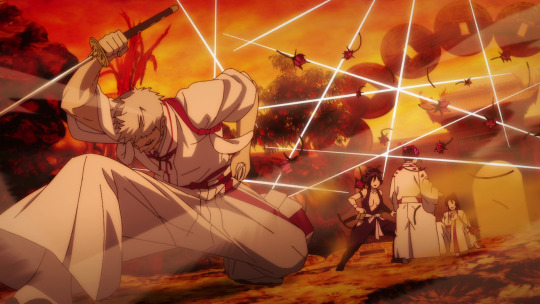
Manga
Ice-Head Gill Ch1
the newest series, debuting on jump today. it was.... alright. I quite enjoy that it's based on norse mythology, not something you see often in manga but on the other hand I don't like how young the mc is. "oh but wsj is for kids it shouldn't be that weird" yes yes the same old tired argument, but he's even younger than the usual jump mcs. but anyway, not much to say about chap 1 tbh, the art's not impressive but it is solid and the designs are good, story is p simple, the kid had to flee his home cause supposedly his dad betrayed the kindgom and now after getting his hands into the dad's diary, he's setting off into the world to find him and stuff, p standard adventure manga type of stuff in the vein of red hood or ginka not that long ago, hopefully for the artist it can last longer than those but we'll see
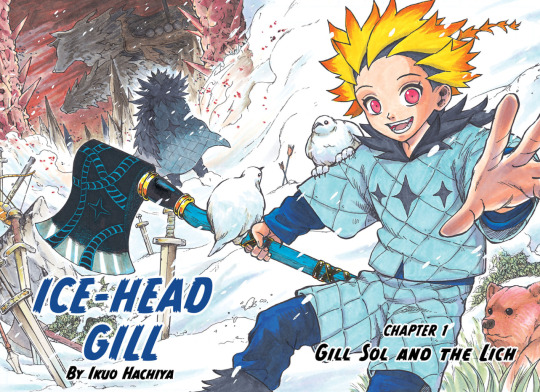
Blooming Love Ch7
cute chap, it started off with them exchanging contacts after the date at the start (moving fast) and then the lad asking his friend for advice about texting since he's not used to it, culminating in him messaging her mistakenly instead of him.. been there brother

Dandadan Ch111
VERY cool chap, the first half had 0 speech bubbles focusing solely on the action, culminating on okarun finally arriving at the battlefield in a cool ass spread, after which the text bubbles started again, the final spread was vey cool too with our cast getting ready to finish up the aliens, really looking forward to next chap since it should be just a lot of cool action
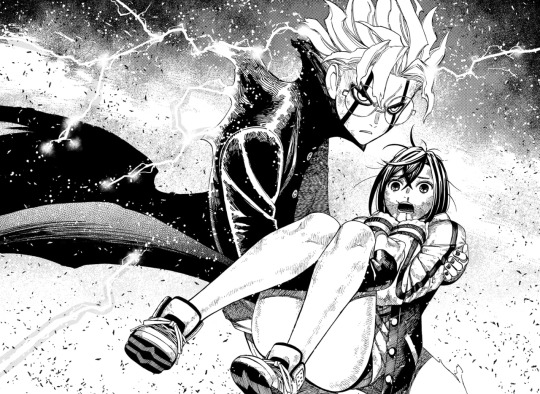

Choujin X Ch38
not only was the chap 50 pages but it also had a TON of exposition so it felt extra long, it could've probably been cut into 2 separate chapters, at the halfway point when they go to the meeting, and we coulda had those chapters more spaced out instead of waiting a billion years for this huge one but oh well

Kaiju 8 Ch88
not much to say about this chap, was just the wrap up of the narumi fight and the start of the hoshina one tho I just wanted to be smug about saying it was gonna be hoshina next on the last chap, very pogged up for this fight I always like his style

ST☆R: Strike it Rich Ch5
nice chap, the rest of the "fight" with nozomi and hina was nice ending with this shot down here of hina lifting her with her leg monka. they also set up the next few opps for hina and hopefully they should last more than just 1 hit so looking forward to that

The Ichinose Family's Deadly Sins Ch30
haven't talked about ichinose in a while but it's just been floundering about, rehashing things over and over, we've only had some real developments the previous and this chap with the sota guy from the dream being revealed to be the older brother of the family. should be ending soon now (hopefully) since there's really not much else to cover so that's good
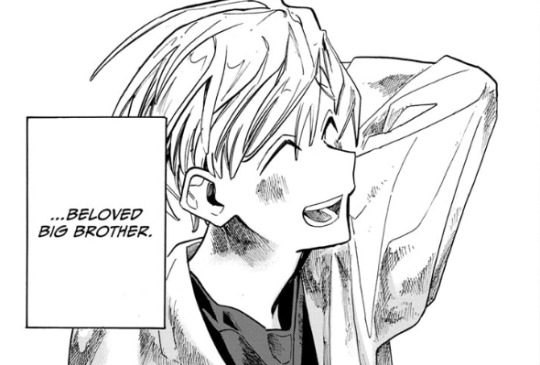
Kill Blue Ch10
uh oh, it's a bit early for you to be figuring that out isn't it? tho the series has been doing quite fine in ratings so I don't think it's heading to cancelation but help but think that when there's a development like this yknow

Witch Watch Ch114
good chap, I didn't expect to get a 1v1 battle arc so soon but I'm really looking forward to this now

Blue Box Ch106
very cute chap with taiki and natsu going back to school after their break and the tension that comes (mostly for taiki) from them hiding the fact they're dating. this is exactly the kinda stuff I was hoping for when they got together so I hope we can get a few more chaps like this. also it's good to see that despite this happening, they're both still focused on their respective sports and the series isn't throwing that to the wayside in favour of romance. tho miura is trustworthy so I wasn't worried
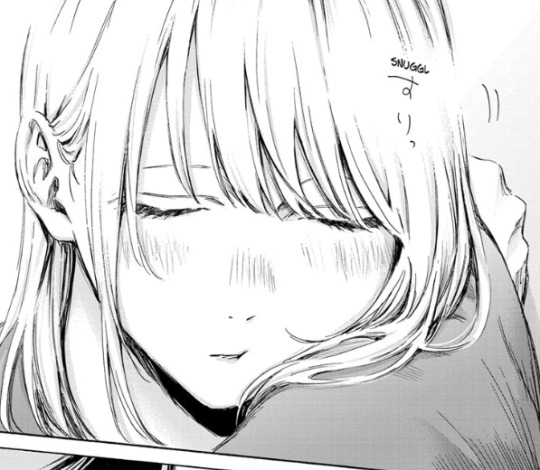
Tenmaku Cinema Ch11
another nice chap but sadly it's still doing p badly in ratings, even with mashle ending next week and ichinose seemingly ending soon I don't know if it'll survive, which is a big shame. can only cross my fingers and hope but not holding my breath
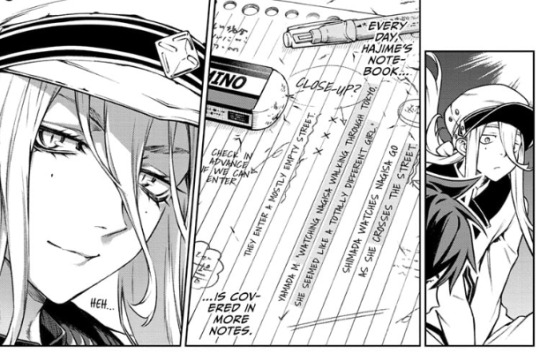
Martial Master Asumi Ch2
oooh, good chap, really keeping the momentum from ch1 that's good that's good. anyway I'm predicting nito is gonna lose so we can get some more backstory™ for okiba but despite losing the dad will still let her participate in that tournament thing but we'll see

Cipher Academy Ch29
good chap like usual finishing up the first class vs class battle with our protags winning without the leaders even having to participate. also wanna praise how good cipher's composition is in general, you can see it in the page I picked but also on the final page of the chap where they introduce class B the next enemies for the class battle. cipher was in the middle of the ratings this week, so I would be p pogged up if next week is the same, giving me some assurance that it won't get canceled suddenly anymore

Sakamoto Days Ch124
nice and action filled chapter, the battle against slur's goons has finally started and with quite the bang, looking forward to some quality setpiece scenes in the next few chaps

Mashle Ch161
next chap is gonna be the last and it's weird seeing it go even if I wasn't here from the start, chap was alright not much to say, just wrapping up the after fight stuff and what was gonna happen with all the people that died and stuff. expecting the finale to have what everyone ends up doing in the future and that kinda stuff

Undead Unluck Ch164
what the hell they made mui busted in this loop let's go, it was always a shame she didn't get to do much til the end in the previous loop. it's a shame 2 of shen's fights against union were resolved so quickly like that but knowing this makes it ok, looking forward to them fighting

The Elusive Samurai Ch115
it's refreshing finally having a full chapter with out protagonists after so long, tho the manga is indeed following historical fact which is quite worrying for our boy tokiyuki. but nevermind all that, a new cute girl is joining the cast and that's what matters baby
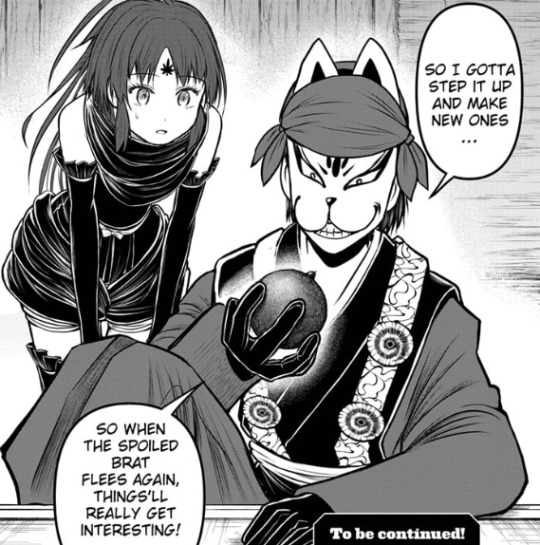
Akane-banashi Ch67
EXTREMELY good chap, sheesh akane never ceases to impress me, don't got anything to say other than wow they didn't show her score at the end of the performance at the end of the chap but it'll be at the start of the next one and I'm still very confident in my prediction. this performance being so good just made me more excited for akane's tho, can't wait for it to start

Ayakashi Triangle Ch134
argh quite the cliffhanger to leave on when there's not gonna be a chap next week, good chap tho it was nice seeing shadow mei help despite her still being tsun about it

#quite late today cause I didn't get to watch my shows yesterday like usual so had to do it after reading jump#silver talks animanga
2 notes
·
View notes
Text
Beyond the Canvas: Immerse Yourself in Dazzling Art Experiences
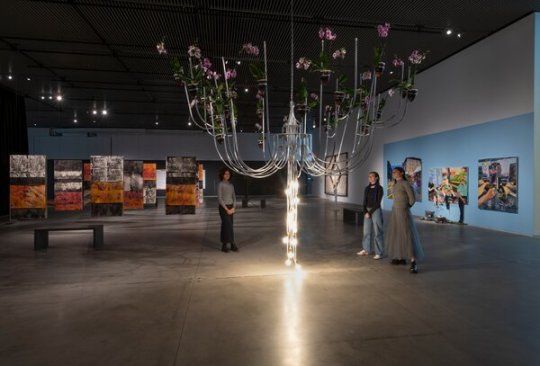
This week, transcend the ordinary and delve into a global tapestry of artistic experiences. From gravity-defying dreamscapes to introspective explorations of light and identity, these five exhibitions promise to ignite your imagination and challenge your perceptions. 1. Carlijn Jacobs & Sabine Marcelis: Sleeping Beauty (Foam, Amsterdam, Netherlands) Opening: January 29th, 2024 Slip into a world of distorted realities and fantastical dreamscapes with this collaboration between photographer Carlijn Jacobs and designer Sabine Marcelis. Jacobs' surreal imagery, known for its warped perspectives and dreamlike atmospheres, collides with Marcelis' otherworldly aesthetic, creating an immersive and mind-bending experience. Expect floating landscapes, gravity-defying objects, and distorted portraits that blur the lines between reality and fantasy. For more> https://www.foam.org/events/carlijn-jacobs Highlights: "The Ballroom," a large-scale installation featuring shimmering curtains and warped furniture, and "The Garden," a surreal landscape with oversized flowers and floating chairs. 2. Olafur Eliasson: the weather experiment (Louisiana Museum of Modern Art, Humlebæk, Denmark) Opening: February 2nd, 2024 Embark on a sensory journey through light, space, time, and perception in Olafur Eliasson's captivating experiments. Immerse yourself in large-scale installations that explore atmospheric phenomena like rainbows, mist, and artificial moonlight. Prepare to be challenged and intrigued by Eliasson's inventive approach to manipulating light and temperature, questioning our understanding of the world around us. Highlights: "Your rainbow panorama," a breathtaking rainbow spanning the museum's entrance hall, and "The fog machine," a room filled with an ever-shifting mist that distorts your perception of space and time. For more > https://www.phaidon.com/agenda/art/articles 3. New Paintings: Cecily Brown (Gagosian, London, UK) Opening: February 2nd, 2024 Dive into a vibrant world of mythology and dreamscapes with renowned American artist Cecily Brown's new large-scale paintings. Known for her expressive figures and dynamic compositions, Brown's artwork blends mythology, personal narratives, and dreamlike imagery. Prepare to be captivated by her bold brushstrokes, vivid colors, and the raw emotional energy that pulsates through each canvas. Highlights: Expect new works exploring themes of desire, transformation, and the fluidity of identity. For more> https://galeriemagazine.com/three-major-painting-exhibitions-not-missed-new-york/ 4. Beyond Words: The Art of Illustration (British Library, London, UK) Opening: February 3rd, 2024 Travel through centuries of storytelling through this exhibition showcasing the power of illustration. Witness original artwork from iconic illustrators like Aubrey Beardsley, Arthur Rackham, and Quentin Blake, exploring diverse genres from children's literature to political satire. Discover how artists use visual language to interpret texts, shape narratives, and evoke emotions. Highlights: Original illustrations from famous classics like Alice's Adventures in Wonderland and The Wind in the Willows, alongside contemporary works addressing social issues and political commentary. For more> https://www-ianvisits-co-uk. 5. Faith Ringgold: American People (San Francisco Museum of Modern Art, USA) Opening: February 4th, 2024 Themes: Witness a powerful journey through American identity, race, and social justice in this major retrospective of Faith Ringgold, a pioneering African American artist. Explore her iconic narrative quilts, featuring vibrant fabrics and bold storytelling, which tackle issues of racism, sexism, and the ongoing struggle for equality. Be prepared to be moved and inspired by Ringgold's unwavering voice and artistic activism. Highlights: Large-scale quilts like "The American People Series" (1963-1964) and "The Slave Ship" (1994), alongside mixed-media works and archival materials. For more> https://visit.mcachicago.org/exhibitions/faith-ringgold-american-people/ These are just some of the incredible exhibitions opening this week, offering diverse experiences for every artistic taste. So, get out there, explore, and let your artistic spirit take flight! Read the full article
0 notes
Text
By Jonathan Taylor
Jet-lagged and exhausted, LeVar Burton rallied his youthful energy as he exited customs at New York’s JFK airport and climbed into a waiting limo. He had just traveled from the Zambezi River in Zambia, where he had filmed a segment for the April 4, 1982, episode of ABC’s “The American Sportsman.”
The car made its way from Queens to Manhattan, dropping him off at Central Park. He was there to shoot the pilot for a new public television show aimed at encouraging early learners to love books.
The show was to be called “Reading Rainbow.”
He was not entirely sure what the job was, and certainly not aware that it would become one of his signature roles. It didn’t matter. The son of a former teacher and a passionate believer in learning, reading, exploring and growing, Burton was all-in on this new adventure.
“Everything about it just made sense,” Burton says, more than 40 years later. “It was about literature and the written word, it was about kids, it was about having kids discover the power of literature through the medium of television and that was why ‘Reading Rainbow’ was such a radical departure from other shows of its era.”
From the moment he first met the “Reading Rainbow”crew, Burton demonstrated not one iota of star attitude.
“He showed up, got out of the limo, and I said, ‘Hey, how are you?’” Cecily Truett, co-creator, head writer and producer on the show for most of its run, recalls. “He said, ‘Well, I just got off the red-eye, so…’ I said, ‘Well, what can we do for you? How can we make you comfortable?’ He said, ‘You know, I’d love to have a glass of orange juice and a toothbrush.’ And that was it.
“He walked right on to the set, he ran through his lines and for the next 25 years he was on the set, on time, with his lines memorized....”
“For 155 shows,” her husband, Larry Lancit, another of the show’s creators, producers and directors, added.
Burton had to hurry back from Africa to New York because a skeleton crew was waiting to shoot the pilot episode, including anxious documentarians Truett and Lancit and fellow creator and executive producer Twila C. Liggett, a onetime elementary school teacher who had realized TV was the ideal medium to reach and influence young children. If “Reading Rainbow” delivered on its promise that a children’s show focused on the joy and value of reading could be set in the real America rather than on Sesame Street or in Mister Rogers’ neighborhood, it would get the blessing from PBS.
It did the trick. This month marks the 40th anniversary of the national premiere of one of the longest-running children’s shows in the history of public television.
That pilot episode centered around the children’s book “Gila Monsters Meet You at the Airport” by Marjorie Weinman Sharmat and Byron Barton. It is about a young New Yorker whose family is moving to Arizona, and who faces the fear felt by any kid torn from the community he or she has known and grown up with to resettle someplace distant, almost alien. (Spoiler alert: No desert animals meet the young man and his family upon arrival.)
As was the case in every episode that followed, Burton played host, trusted friend and calming presence. He was the face of the show and its most visible advocate, which was needed, since Liggett was forever searching for funding to pay for the show’s ambitious storytelling and wanderlust. Having the charismatic, passionate host on every episode and advocating on behalf of the show to Congress, parent groups and elsewhere made Liggett’s job much easier. Burton stayed with the show even when he got a much higher-profile job, as Geordi La Forge on the syndicated “Star Trek: The Next Generation.”
With the pilot shot — once the show got on the air, it actually was Episode 8 — all that was needed was the blessing, and partial funding, of the Corp. for Public Broadcasting (CPB), the private, nonprofit corporation charged by Congress to financially support PBS shows. Rev. Donald L. Marbury, at that time the vice president for programming at CPB, recalls the high-stakes meeting when Liggett presented the results of the pilot to him and his colleagues:
“In such meetings you couldn’t show too much enthusiasm or give too many positive signals because we were the Corporation, and we were bound by all kinds of processes and procedures. We did not have dollars to just say, ‘OK, we get it. Here, take the money.’ We had to go through panels, we had to go through outside groups and experts to come in and ratify what we thought were good ideas.”
And yet, because he remembered his own elementary school teacher decades before imbuing him with a love of books and reading, Marbury concedes, “When Twila comes in with this concept for ‘Reading Rainbow,’ you know I’m predisposed. I’m a kindred spirit. And so, she kind of had me from jump street, if you will. She had me at hello.”
Meanwhile, Lancit and Truett took a well-earned vacation to Puerto Rico, though their minds were elsewhere.
“Our whole future depended on whether we were going to do this thing or not because we were going to have to do 15 [episodes that first season],” Lancit remembers. “They wanted to show it in summer of ’83 and here it was January of ’82. So, we’re gonna have to really haul ass to get it all done.”
“We’re sitting on a balcony in Puerto Rico, overlooking the ocean and there was a tremendous rainstorm, when a big rainbow came across the sky and damned if the phone didn’t ring. It was Twila. She said they loved it at CPB and basically authorized the funds,” Lancit recalls. “So, it looks like we’re going to get started.”
Much of what became the template for “Reading Rainbow” — built around Liggett’s ideas that the show should encourage early readers to read to learn instead of simply learning to read — had already been decided earlier in the process, after the Lancits, Liggett and a few others had received the initial OK from CPB to develop the pilot.
“We knew what we wanted,” Lancit says. “If there was going to be a feature book and some sort of adaptation of that book, we decided that there really needed to be some sort of touchstone in real life that made the book come alive, by doing some sort of real-life experience that you can attach to the story that’s in the book. That was the genesis of what we called our field segment. And then we said, ‘Well, how do we introduce additional books?’ And we said, ‘Let’s do book reviews,’ and so we came up with the idea to have kids at the end of each show review books that were similar in scope, or message, or story.”
Aside from host LeVar Burton’s signature line before the young children would tout their favorite book — “But don’t take my word for it” — the show was different each time, which kept it fresh. A new feature book was showcased every episode, read by various known and unknown voices.
And unlike most other shows for kids, whether on PBS, commercial channels or, by the mid ’80s, cable, “Reading Rainbow”had no fixed set. Instead, it would travel — often to Southern California, in part to be close to LeVar Burton’s home — as well as across the country, around the world (when budgets allowed, which wasn’t often) or just across New York City, in pursuit of the right expert, the ideal setting, the most photogenic location to shoot a field piece. And, of course, there were boys and girls of all races and ethnicities to recommend additional reading options.
Among the notables who narrated the Feature Book that first season were actors Madeline Kahn (“Bea and Mrs. Jones”), James Earl Jones (“Bringing the Rain to Kapiti Plain”) and Lauren Tom (“Liang and the Magic Paintbrush”), and singer Lou Rawls (“Ty’s One-Man Band”).
One other book featured that first season was “Arthur’s Eyes,” read by a pre-controversy Bill Cosby), which author Marc Brown remembers as a key moment for him, “because that’s when Arthur started to gain traction with teachers, librarians, kids.”
In fact, it wasn’t long after that book was featured on “Rainbow”that Brown was approached by PBS about adapting his Arthur stories into an animated series. WGBH Boston producer Carol Greenwald emphasized that the aim of the series was to encourage kids to read.
That was different from some of the other offers he’d received to bring his popular aardvark character to TV. “I had had two other inquiries about Arthur on television, but it was a Saturday morning kind of thing. I would’ve had no control over what would happen to Arthur; they could put a gun in his backpack. And I didn’t want that to happen.”
Indeed, while PBS Kids, as it’s known now, was and remains a safe and welcoming destination for youngsters, it wasn’t the only place for kids to be entertained by TV. Shows aimed at young viewers aired on the big networks as well as on local stations, especially on Saturday mornings, but also in the afternoons, after school.
Until the passage of the Children’s Television Act in 1990, which wasn’t fully implemented until 1993, broadcast TV was largely unregulated — or, more accurately, was self-regulated.
That’s how a show like “He-Man and the Masters of the Universe,” which also began in 1983,got on the air. Based on the He-Man toys from Mattel, the series’ blend of product and programming spurred loud objections from parent groups, TV watchdogs and others before becoming a huge hit on commercial TV.
Sen. Edward Markey (D-Mass.) has waged a career-long crusade to hold broadcasters accountable for what they aired, particularly to children. He recalls, not at all fondly, his battles with President Ronald Reagan’s Federal Communications Commission, under the leadership of Chairman Mark C. Fowler, which followed the Reaganomics model and rescinded all of the regulations governing children’s TV.
So, when Markey, then a member of the House of Representatives, managed to pass a bill in 1984 that reinstated and even strengthened the rules that had formerly been in place, it was no surprise that the president vetoed it. Markey got it passed again during the first President Bush’s term, and he too refused to sign it, twice. It wasn’t until Democrat Bill Clinton became president and appointed his own FCC chairman, Reed Hundt, that the Children’s Television Act finally became law.
Even now, 30 years later, Markey remains bitter about the fights and compromises necessary to pass meaningful legislation regarding kids’ TV. Markey says the Reagan and Bush administrations “showed a deep-seated obeisance to the broadcast industry, almost genuflecting at their every whim, notwithstanding the harm that was being done to children across the country.”
It was in this environment that “Reading Rainbow”launched, a co-production of Nebraska Educational TV in Lincoln, where Liggett was based, and WNED in Buffalo, which was involved in the show from the beginning as well. Premiering any show is challenging, but it was logarithmically harder for this show, which had no fixed location, needed rights to multiple books for each episode, had to fight hard, particularly in the early seasons, to get placement on local PBS stations, and do all of it under tight budget constraints.
As far as figuring out which books to feature, Truett remembers coming up with basic standards, in collaboration with Liggett and some of the academic advisors the producers consulted regularly.
“Is it telegenic? Does it lead to an adventure that would excite the viewer? Is it kid-friendly? Is it about dinosaurs? (That’s a no-brainer.) Did it meet our diversity standards? Were there books that were reflective of children of all colors and cultures? … There were many, many standards for what got selected as a feature book.”
Then there was the matter of locking down the rights to spotlight the books, which was predictably agonizing, at least in the first season. The hard work of securing rights, and money, fell to Liggett. She chuckles now at the memory of dealing with skeptical publishers for rights to the book, since by the end of the first season, publishers couldn’t do enough to get their books on the show.
But in 1982, as the first season of shows was coming into focus, it was still an untested, unproven proposition when Liggett went to Simon & Schuster to get rights to adapt “Gila Monsters” for TV.
The Simon & Schuster executive couldn’t understand why her company would let a TV show have rights to the book; for publishing houses, the so-called “boob tube” was the enemy of reading.
“When we first started approaching book publishers to tell them about this and secure these rights, we were initially greeted with a lot of suspicion and questions like ‘What’s this all about?’” Marc Bailin, Truett and Lancit’s attorney who helped negotiate book rights, remembers. “Within a few years, the publishers were clamoring to have their book be a ‘Reading Rainbow’ book.”
That’s no surprise since, from the start, having a book featured on the show “increased the book sales of a lot of those titles markedly,” Bailin says.
By the time “Reading Rainbow” aired its final episode on Nov. 10, 2006, it had produced 155 in all, each with the same essential structure, each different in content from the other 154. It taught multiple generations of young children to love to read, to explore and keep their eyes open to new experiences, new people, new ideas.
Never the icon that its friendly rivals “Sesame Street” or “Mister Rogers’ Neighborhood” were, and drawing nowhere near the audience numbers of cable TV behemoth Nickelodeon’s hits, “Reading Rainbow”was still a show watched and beloved by early readers, their parents, teachers and others.
As Burton explains, “We recognized the impact on the audience and we leaned into it. It made sense, we were there creating content for children to enhance their minds, hearts and souls, right? And given that opportunity, we didn’t want to squander it.”
0 notes
Text
By Jonathan Taylor
Jet-lagged and exhausted, LeVar Burton rallied his youthful energy as he exited customs at New York’s JFK airport and climbed into a waiting limo. He had just traveled from the Zambezi River in Zambia, where he had filmed a segment for the April 4, 1982, episode of ABC’s “The American Sportsman.”
The car made its way from Queens to Manhattan, dropping him off at Central Park. He was there to shoot the pilot for a new public television show aimed at encouraging early learners to love books.
The show was to be called “Reading Rainbow.”
He was not entirely sure what the job was, and certainly not aware that it would become one of his signature roles. It didn’t matter. The son of a former teacher and a passionate believer in learning, reading, exploring and growing, Burton was all-in on this new adventure.
“Everything about it just made sense,” Burton says, more than 40 years later. “It was about literature and the written word, it was about kids, it was about having kids discover the power of literature through the medium of television and that was why ‘Reading Rainbow’ was such a radical departure from other shows of its era.”
From the moment he first met the “Reading Rainbow”crew, Burton demonstrated not one iota of star attitude.
“He showed up, got out of the limo, and I said, ‘Hey, how are you?’” Cecily Truett, co-creator, head writer and producer on the show for most of its run, recalls. “He said, ‘Well, I just got off the red-eye, so…’ I said, ‘Well, what can we do for you? How can we make you comfortable?’ He said, ‘You know, I’d love to have a glass of orange juice and a toothbrush.’ And that was it.
“He walked right on to the set, he ran through his lines and for the next 25 years he was on the set, on time, with his lines memorized....”
“For 155 shows,” her husband, Larry Lancit, another of the show’s creators, producers and directors, added.
Burton had to hurry back from Africa to New York because a skeleton crew was waiting to shoot the pilot episode, including anxious documentarians Truett and Lancit and fellow creator and executive producer Twila C. Liggett, a onetime elementary school teacher who had realized TV was the ideal medium to reach and influence young children. If “Reading Rainbow” delivered on its promise that a children’s show focused on the joy and value of reading could be set in the real America rather than on Sesame Street or in Mister Rogers’ neighborhood, it would get the blessing from PBS.
It did the trick. This month marks the 40th anniversary of the national premiere of one of the longest-running children’s shows in the history of public television.
That pilot episode centered around the children’s book “Gila Monsters Meet You at the Airport” by Marjorie Weinman Sharmat and Byron Barton. It is about a young New Yorker whose family is moving to Arizona, and who faces the fear felt by any kid torn from the community he or she has known and grown up with to resettle someplace distant, almost alien. (Spoiler alert: No desert animals meet the young man and his family upon arrival.)
As was the case in every episode that followed, Burton played host, trusted friend and calming presence. He was the face of the show and its most visible advocate, which was needed, since Liggett was forever searching for funding to pay for the show’s ambitious storytelling and wanderlust. Having the charismatic, passionate host on every episode and advocating on behalf of the show to Congress, parent groups and elsewhere made Liggett’s job much easier. Burton stayed with the show even when he got a much higher-profile job, as Geordi La Forge on the syndicated “Star Trek: The Next Generation.”
With the pilot shot — once the show got on the air, it actually was Episode 8 — all that was needed was the blessing, and partial funding, of the Corp. for Public Broadcasting (CPB), the private, nonprofit corporation charged by Congress to financially support PBS shows. Rev. Donald L. Marbury, at that time the vice president for programming at CPB, recalls the high-stakes meeting when Liggett presented the results of the pilot to him and his colleagues:
“In such meetings you couldn’t show too much enthusiasm or give too many positive signals because we were the Corporation, and we were bound by all kinds of processes and procedures. We did not have dollars to just say, ‘OK, we get it. Here, take the money.’ We had to go through panels, we had to go through outside groups and experts to come in and ratify what we thought were good ideas.”
And yet, because he remembered his own elementary school teacher decades before imbuing him with a love of books and reading, Marbury concedes, “When Twila comes in with this concept for ‘Reading Rainbow,’ you know I’m predisposed. I’m a kindred spirit. And so, she kind of had me from jump street, if you will. She had me at hello.”
Meanwhile, Lancit and Truett took a well-earned vacation to Puerto Rico, though their minds were elsewhere.
“Our whole future depended on whether we were going to do this thing or not because we were going to have to do 15 [episodes that first season],” Lancit remembers. “They wanted to show it in summer of ’83 and here it was January of ’82. So, we’re gonna have to really haul ass to get it all done.”
“We’re sitting on a balcony in Puerto Rico, overlooking the ocean and there was a tremendous rainstorm, when a big rainbow came across the sky and damned if the phone didn’t ring. It was Twila. She said they loved it at CPB and basically authorized the funds,” Lancit recalls. “So, it looks like we’re going to get started.”
Much of what became the template for “Reading Rainbow” — built around Liggett’s ideas that the show should encourage early readers to read to learn instead of simply learning to read — had already been decided earlier in the process, after the Lancits, Liggett and a few others had received the initial OK from CPB to develop the pilot.
“We knew what we wanted,” Lancit says. “If there was going to be a feature book and some sort of adaptation of that book, we decided that there really needed to be some sort of touchstone in real life that made the book come alive, by doing some sort of real-life experience that you can attach to the story that’s in the book. That was the genesis of what we called our field segment. And then we said, ‘Well, how do we introduce additional books?’ And we said, ‘Let’s do book reviews,’ and so we came up with the idea to have kids at the end of each show review books that were similar in scope, or message, or story.”
Aside from host LeVar Burton’s signature line before the young children would tout their favorite book — “But don’t take my word for it” — the show was different each time, which kept it fresh. A new feature book was showcased every episode, read by various known and unknown voices.
And unlike most other shows for kids, whether on PBS, commercial channels or, by the mid ’80s, cable, “Reading Rainbow”had no fixed set. Instead, it would travel — often to Southern California, in part to be close to LeVar Burton’s home — as well as across the country, around the world (when budgets allowed, which wasn’t often) or just across New York City, in pursuit of the right expert, the ideal setting, the most photogenic location to shoot a field piece. And, of course, there were boys and girls of all races and ethnicities to recommend additional reading options.
Among the notables who narrated the Feature Book that first season were actors Madeline Kahn (“Bea and Mrs. Jones”), James Earl Jones (“Bringing the Rain to Kapiti Plain”) and Lauren Tom (“Liang and the Magic Paintbrush”), and singer Lou Rawls (“Ty’s One-Man Band”).
One other book featured that first season was “Arthur’s Eyes,” read by a pre-controversy Bill Cosby), which author Marc Brown remembers as a key moment for him, “because that’s when Arthur started to gain traction with teachers, librarians, kids.”
In fact, it wasn’t long after that book was featured on “Rainbow”that Brown was approached by PBS about adapting his Arthur stories into an animated series. WGBH Boston producer Carol Greenwald emphasized that the aim of the series was to encourage kids to read.
That was different from some of the other offers he’d received to bring his popular aardvark character to TV. “I had had two other inquiries about Arthur on television, but it was a Saturday morning kind of thing. I would’ve had no control over what would happen to Arthur; they could put a gun in his backpack. And I didn’t want that to happen.”
Indeed, while PBS Kids, as it’s known now, was and remains a safe and welcoming destination for youngsters, it wasn’t the only place for kids to be entertained by TV. Shows aimed at young viewers aired on the big networks as well as on local stations, especially on Saturday mornings, but also in the afternoons, after school.
Until the passage of the Children’s Television Act in 1990, which wasn’t fully implemented until 1993, broadcast TV was largely unregulated — or, more accurately, was self-regulated.
That’s how a show like “He-Man and the Masters of the Universe,” which also began in 1983,got on the air. Based on the He-Man toys from Mattel, the series’ blend of product and programming spurred loud objections from parent groups, TV watchdogs and others before becoming a huge hit on commercial TV.
Sen. Edward Markey (D-Mass.) has waged a career-long crusade to hold broadcasters accountable for what they aired, particularly to children. He recalls, not at all fondly, his battles with President Ronald Reagan’s Federal Communications Commission, under the leadership of Chairman Mark C. Fowler, which followed the Reaganomics model and rescinded all of the regulations governing children’s TV.
So, when Markey, then a member of the House of Representatives, managed to pass a bill in 1984 that reinstated and even strengthened the rules that had formerly been in place, it was no surprise that the president vetoed it. Markey got it passed again during the first President Bush’s term, and he too refused to sign it, twice. It wasn’t until Democrat Bill Clinton became president and appointed his own FCC chairman, Reed Hundt, that the Children’s Television Act finally became law.
Even now, 30 years later, Markey remains bitter about the fights and compromises necessary to pass meaningful legislation regarding kids’ TV. Markey says the Reagan and Bush administrations “showed a deep-seated obeisance to the broadcast industry, almost genuflecting at their every whim, notwithstanding the harm that was being done to children across the country.”
It was in this environment that “Reading Rainbow”launched, a co-production of Nebraska Educational TV in Lincoln, where Liggett was based, and WNED in Buffalo, which was involved in the show from the beginning as well. Premiering any show is challenging, but it was logarithmically harder for this show, which had no fixed location, needed rights to multiple books for each episode, had to fight hard, particularly in the early seasons, to get placement on local PBS stations, and do all of it under tight budget constraints.
As far as figuring out which books to feature, Truett remembers coming up with basic standards, in collaboration with Liggett and some of the academic advisors the producers consulted regularly.
“Is it telegenic? Does it lead to an adventure that would excite the viewer? Is it kid-friendly? Is it about dinosaurs? (That’s a no-brainer.) Did it meet our diversity standards? Were there books that were reflective of children of all colors and cultures? … There were many, many standards for what got selected as a feature book.”
Then there was the matter of locking down the rights to spotlight the books, which was predictably agonizing, at least in the first season. The hard work of securing rights, and money, fell to Liggett. She chuckles now at the memory of dealing with skeptical publishers for rights to the book, since by the end of the first season, publishers couldn’t do enough to get their books on the show.
But in 1982, as the first season of shows was coming into focus, it was still an untested, unproven proposition when Liggett went to Simon & Schuster to get rights to adapt “Gila Monsters” for TV.
The Simon & Schuster executive couldn’t understand why her company would let a TV show have rights to the book; for publishing houses, the so-called “boob tube” was the enemy of reading.
“When we first started approaching book publishers to tell them about this and secure these rights, we were initially greeted with a lot of suspicion and questions like ‘What’s this all about?’” Marc Bailin, Truett and Lancit’s attorney who helped negotiate book rights, remembers. “Within a few years, the publishers were clamoring to have their book be a ‘Reading Rainbow’ book.”
That’s no surprise since, from the start, having a book featured on the show “increased the book sales of a lot of those titles markedly,” Bailin says.
By the time “Reading Rainbow” aired its final episode on Nov. 10, 2006, it had produced 155 in all, each with the same essential structure, each different in content from the other 154. It taught multiple generations of young children to love to read, to explore and keep their eyes open to new experiences, new people, new ideas.
Never the icon that its friendly rivals “Sesame Street” or “Mister Rogers’ Neighborhood” were, and drawing nowhere near the audience numbers of cable TV behemoth Nickelodeon’s hits, “Reading Rainbow”was still a show watched and beloved by early readers, their parents, teachers and others.
As Burton explains, “We recognized the impact on the audience and we leaned into it. It made sense, we were there creating content for children to enhance their minds, hearts and souls, right? And given that opportunity, we didn’t want to squander it.”
0 notes
Text
I have followed Atlas Obscura for a while. As a lover of travel and food, the gastronomic aspect of Gastro Obscura: A Food Adventurer’s Guide by Cecily Wong and Dylan Thuras. immediately appeals to me. Food is a universal language and a part of every life occasion happy and sad. Food brings people together. In a world so divided, it is wonderful to see every effort to identify that which unites us.
Reviewed for NetGalley.
0 notes
Text

His friend always spoke about Cecily in such high regard that Shirou was under the impression she was a miracle worker. Even when Sonia had her bouts of fancy she had always been very disciplined and some of her rebellious inclinations were easy to foresee and carter to. The perchance for the occult, for example, or how much she enjoys horror movies. Only occasionally she would be a little more adventurous so Cecily certainly would be able to arrange or at least foresee a few contingency plans --- or so Emiya believed. If he was right on the money or if Sonia was overselling it was still up to debate.
❝ Ah, so it is the latter. I understand, you intervening in your cousin’s hunt for fun could actually be detrimental to my chances of escaping unscratched ? Or perhaps you are like me and doesn’t know the basics of surviving that kind of party ? ❞ he teased. It was hard to imagine Sonia engaging in debauchery indulgence even if she might be surrounded by it due to the nature of her job as the crown princess. ❝ You know, the fact that you won’t compromise on your core values is one of the things that is most admirable about you. ❞ as someone who travels and deals with all sorts of powerful individuals, Shirou had witnessed many kinds of leaders. The more powerful they are they usually lean to use their influence to get what they want – more power, money, sex, drugs… Those who have it all like to play fast and loose with morals, accumulating all sorts of excess and discarding those who aren’t on their level without a second thought. He’d heard about Sonia’s mother’s lovers from rumors and hints from the princess herself, yet the queen’s perfectly curated image paints her as a saint. It was praiseworthy that Sonia wants to uphold her morals and remain hopeful in the process. ❝ I can tell people tend to think you are naïve, they think that not becoming jaded or petty like them means ignorant. Your kindness is both your greatest asset but also your weak spot. The people of Novoselic are fortunate to have such a wonderful ruler. ❞ ---Still memories of a certain King of Knights made his heart feel tight.
❝ I think it might be a good idea to keep Novoselic relatively magic-free. ❞ he spoke frankly ❝ Political relationships are usually complicated enough, but mages can be downright inhumane. Some think as non-mages as little more than cattle, so a few selected ones you may be able to trust can inject some money in the country and offer support against mages with funny ideas. Luvia-san and her family can play their reputations of the “hyenas of Europe” but they are very caring and never go back with their word. ❞ he was actually a little surprised that the Church and its related branches like the Burial Agency barely have any dealings with Novoselic as well. ❝And I wasn’t talking about my own abilities as a mage, I was talking about people like you. You might be royal and a crown princess, but for most mages it is the same as nothing. Royal or homeless, if you don’t have magic circuits it makes barely any difference. During a ritual that took place in Fuyuki no-one paid any attention to me because at the time I didn’t have enough magic circuits to be considered a mage – just part of the peanut gallery. ❞ he revealed whilst dispelling her confusion ❝ This is one of the many reasons why you should be careful if you ever decide to allow the Mage’s Association to go back to Novoselic. Tohsaka and Luvia-san are exceptions, and there are a few individuals who won’t dismiss you . But you should be wary of mages, thankfully most of them chose to isolate themselves from regular humans unless it benefits them somehow. ❞ that was a harsh reality and kind of a dour conversation subject.
-- That was immediately brushed away by Sonia’s outburst, that caused Shirou to pause and blink before chuckling to the point of going “ow ow” thanks to his stitches. Once he’d calmed down, he was able to articulate better: ❝ I’m always traveling around and I can’t keep my books. I end up giving them away or leaving them behind because I can’t store them. Knowing that a book that made me happy is in good hands will be perfect. ❞ he explained ❝ I know that a princess like you might not think too highly of second-hand articles but I promise you that I usually take good care of books. ❞ …A few of them had bullet holes tho. Those are usually discarded. ❝ A book is meant to be read after all. And to share a story with someone I know might enjoy it would be the best outcome, don’t you think ? But if you don’t want them, I understand. ❞

He watched as the girl struggled, it was indeed a little chilly and he was afraid that the blanket he was using might have been dirtied with his blood so it would also be no good. There was only one thing that he could do: ❝ Tʀᴀᴄᴇ ᴏɴ ! ❞ he hummed, mana pouring through his magic circuits activating it. In the past it would take a few seconds to retrieve the structure and picture it in his mind, now it was instantaneous : it was a dark burgundy windbreaker coat, it was warm enough despite not fitting her current aesthetic. It was also his size, he can’t create anything only reproduce things that he’d seen before. ❝ Use this, it will protect you from the draft. ❞ he indicated, holding it to her.
“I am sure she would appreciate that,” Sonia replied hesitantly. Cecily was the closest thing she had to an older sibling, and with her mother being…her mother, she often took both a personal and professional stake in Sonia’s care. Yes, she needed to ensure the Princess was well-dressed, well-informed, and on-time for every royal engagement, and oversee the various assistants who performed most of the errands for both Sonia and Cecily. But it wasn’t part of the job description to look after Sonia’s heart, and the many times it had fractured, much less shattered. She was as much the guide and planner to Sonia’s life as she was a sounding board, and a friendly ear when she had no one else to turn to. “But Cecily is not fond of surprises, even good ones. She rather enjoys predictability, so a planned visit might be best.”
Sure, he was injured and laying up in one of her many guest rooms at Boudry House, but Sonia couldn’t help but straighten and stare at him. Or rather, the prospect of needing Sonia to come and save him. Him, Shirou, the person who devoted his life to wandering the world in order to aid others. “I…I have no doubt of your ability to consent or decline such advances,” Sonia said, but that wasn’t truly her concern. Shirou’s agency in making his own choices had never been in question. What really mattered was would he want to? Not that his personal affairs were any of her concern. They were just friends. A friend who remembered her mishaps in abandoned homes, complete with her own dirt-caked clumsiness.

And one who didn’t hesitate to praise her, either. So often she was made uncomfortably disgusted by it, admirers who spoke so highly of her virtues without truly knowing her, or if she even possessed them. But this was different, Shirou was different, and Sonia found herself shifting in her chair as he spoke. “Thank you, but if I did become jaded, as you say, I do not think I would be able to serve Novoselic’s people effectively,” She replied. Even if he was right, she still felt awkward acknowledging her virtues. There was a certain amount of humility needed, she thought, in order for her not to become her mother. Or worse, her uncle. “In order to lead and provide hope, and a future worth living, one must care for the country and the people who call it home. My father…he taught me that.”
King Alexandre had also taught his daughter never to decline a good opportunity when it presented itself, that learning something new would ultimately benefit both Sonia and the monarchy. But Sonia wasn’t sure if that applied to a holiday, an intentional meeting with Shirou far away from Novoselic that, for once, was entirely planned and had nothing to do with either of their jobs. “I suppose it is not the most outlandish prospect, at least in ensuring there is time set aside in my schedule to go,” She pondered aloud, to her own surprise. Was she truly considering this? She had spent so much time setting personal affairs aside as much as possible: they ended poorly, either those close to her wanted nothing to do with royal life, or they jumped in head first for the worst reasons. “And of course, I would like to see Hilda. And the parfaits: they are quite good. I suppose I am a brave soul as well, then, as I needed to sample one: they use Novoselic chocolate, after all.”
Sonia tilted her head, confused, at Shirou’s admission of going to school with people like him. He fashioned himself as ordinary and yet the man in her guest room bed was the furthest thing from it. “You speak as if your own magecraft counts for nothing, Shirou, but it does,” She interjected, before she realized what she was truly saying. “It does to me, at least. I am sure your mage friends would agree. Yes, I would be pleased to meet any of your London associates you would like to introduce me to!” It was easier, she thought, than trying to introduce Shirou to England’s aristocrats, much less the British Royal Family. Hilda was the only person in that part of the world she was eager for him to meet, unless her sister did so first. If only due to the fact that she’d spoken of him so often to her friend in recent months that Sonia was sure she would want to actually meet the man who prompted her to question her heart as a teenager. And now, it seemed.
“Well, if we are to watch a film, then I should tuck in,” She decided, pushing her chair away from the table before getting to her feet. Sonia guessed that one of the wardrobes contained spare blankets, but she had no idea which one. In her own house, no less: everything about her life was organized by others, right down to spare blankets. “And I could not take your books from you!,” She interjected, looking over her shoulder to face him while she shoved various knick-knacks aside. “I can certainly request some copies to be ordered and delivered here, especially if your travels do not take you to where you’ve hidden them.”

The books were sorted, but she closed the wardrobe doors in defeat. “Shit, I thought there would be a spare blanket or two stored here,” She sighed, wrapping her arms around her waist. With a shake of her head, she fell back into the plush chair by his bed. “It is simply that these rooms are rather drafty if one is not suitably dressed or covered in blankets. I should go change into proper lounge clothes, though I am sure the staff will notice if I return here in what constitutes as pajamas.” Mainly, noticing that their princess would be implied to be sleeping with the injured patient she hadn’t hesitated to keep in the guest room.
28 notes
·
View notes
Photo

i realised i had posted no photos from my current adventure so here u go:
saltwater curls, sun, seasickness and a sick view
#cecilie's travel adventures#userfaheys#useremrose#userdelya#urlzabini#userviolet#useryenna#jilysupportgroup#fandomaestheticgang#*face
29 notes
·
View notes
Text
2021 Reading Log, pt 36
Last reading log of the year! With 183 books read this year, that’s an average of one book every two days.

176. The Secret Life of Fish by Doug Mackay-Hope. I’ve been looking forward to this book for some time, but like a number of books I’ve eagerly anticipated, it ended up being somewhat disappointing. The book covers fifty different fish species, each with a short chapter covering its anatomy, behavior, evolution, ecology and/or cultural significance, with an original watercolor illustration by the author. Many of these chapters are based on recent research. What’s disappointing is that it doesn’t say what recent research—there’s no works cited, or even just a bibliography. The book really could have used another editing pass, and the mistakes that creep in are large enough to make things difficult to understand. It states, for example, that the trunk of Peter’s elephantnose fish is both its upper and lower lip in different places in the same chapter, and adds a zero such that the origin of hammerhead sharks is pushed from 20 million years ago to 200 million years ago! It’s frustrating especially because with a few relatively minor tweaks, this book could have been great.

177. The Mermaid Atlas by Anna Claybourne, illustrated by Miren Asiaian Lora. Recommended to me by @abominationimperatrix, this is a children’s book covering mermaid legends and sightings worldwide. It is definitely for children, but doesn’t sugarcoat things; it is very clear from the text which mermaids want to drown or eat humans. There’s little skulls decorating the sea floor in some of the pictures, such as the cover art. A number of the mermaids discussed in the book are ones I haven’t heard of before—clearly the author did her research.
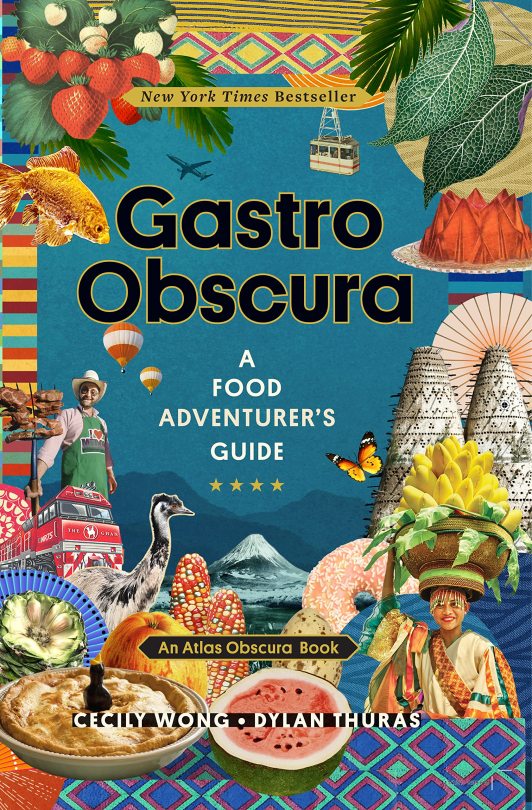
178. Gastro Obscura: A Food Adventurer’s Guide by Cecily Wong and Dylan Thuras. One of my favorite books of the year. This is a global tour of food customs, dishes and restaurants around the world, with articles about pantry staples (like mustard, eggs, milk, blood…) and culinary pioneers. A lot of the foodways discussed involve diaspora and fusion cuisine, and the book talks a lot about the impact of colonialism and slavery on food history. It’s not just far flung things outside the reach of global travelers; there’s references to which products can be bought online or in specialty markets. Now, if only the Sourdough Library was open to the public…
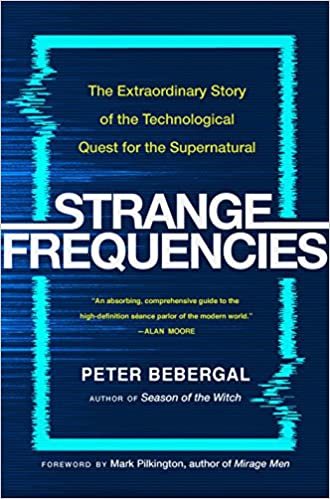
179. Strange Frequencies: The Extraordinary Story of the Technological Quest for the Supernatural by Peter Bebergal. This book covers the intersection of the occult and the technological, stretching back from divine automata in Greek mythology to the modern day EVP phenomenon. Rather than trying to erect barriers between science, magic and religion as avenues of human experience, Bebergal shows how these are all interconnected, and feed into each other to create a sense of enchantment. Bebergal is a skeptic, but an open-minded one, and he talks about his experiments making a spirit radio and playing with reel-to-reel recorders.

180. Star Wars Alien Archive by Katrina Pallant and Natalie Clubb, illustrated by Tim McDonagh. This book consists of illustrations of Star Wars aliens, from the movies up through The Last Jedi and the Clone Wars and Rebels series, with short blurbs about them. I was super into Star Wars between the ages of 8 to 12 (the perfect age, really). So most of the fun of this book was seeing what has changed since then (before the prequels, before Disney) and now, both in terms of new aliens and what details have or have not been kept from the early continuity. The Weequay no longer worship a Magic 8-Ball, for example. I enjoyed looking through this book, but it’s ultimately pretty disposable.

181. Seeing Flowers by Teri Dunn Chance, photography by Robert Llewellyn. I picked this book up from the library assuming it would be about botany, using the flower photographs as a guide. It’s really much more about gardening, although there is some biology sprinkled throughout. Mostly the anatomy of flowers of different families, but it doesn’t do a great job with that. For one thing, there’s no glossary, so for someone like me, who can’t keep their sepals and tepals straight, it wasn’t very helpful. For another thing, the photographs are much more focused on artistic expression than on being useful scientific diagrams. So this book wasn’t for me, is what I’m saying. For someone who wanted some gardening tips and names of interesting cultivars to try, it would probably be more appreciated. But it was very pretty.
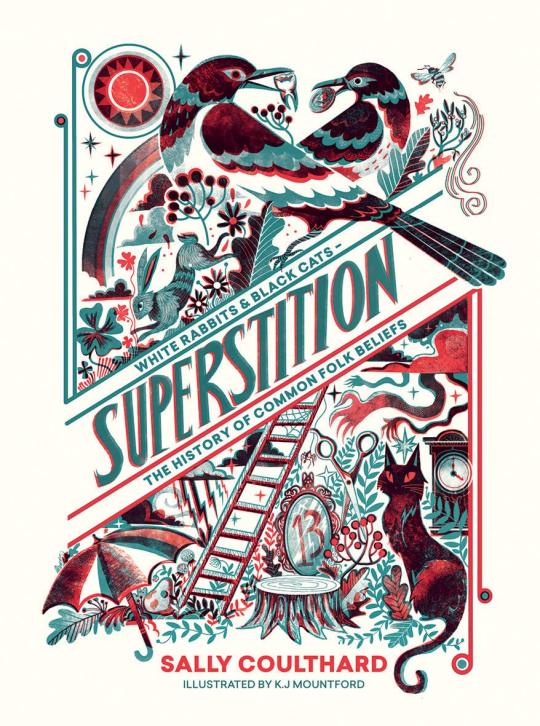
182. Superstition: White Rabbits and Black Cats—the History of Common Folk Beliefs by Sally Coulthard, illustrated by K.J. Mountford. I didn’t realize when I picked it up that this book has a gimmick. It has a Light Side and a Dark Side, which are upside down of each other, detailing good luck and bad luck superstitions respectively. That’s fun. What’s less fun is that the Dark Side often has black text on a dark background, making it a bit of a pain to read. The information within it is good, and I learned some things, but I do wish it had a bibliography somewhere.

183. Fantastic Creatures of the Mountains and Seas by Jiankun Sun, illustrated by Siyu Chen, translated by Howard Goldblatt. I started the year by reading a bestiary, so I figured I’d end the year the same way. This is a translation of a modern commentary on the classic Chinese Guideways through Mountains and Seas. It is by no means a complete coverage of the work—115 or so creatures and gods were selected from it, given commentary and lovely three color illustrations (white, black and red). The publisher’s foreword talks about how tied together age and respectability are among China’s academic scene, so apparently publishing this book, with both authors in their early 20s, was something of a risk. But the perspective is definitely different, and breathes life into the stories and creatures therein. If you want a more scholarly, complete coverage of the Guideways, read Richard Strassberg’s A Chinese Bestiary. But this is a great second stop for exploring this text.
#reading log#fish#marine biology#monster book#star wars#paranormal#occult#guideways through mountains and seas#superstition#food#atlas obscura#mermaid#botany#children's books
82 notes
·
View notes
Text
TSC Groups As Stereotypical High School Friend Groups (Part 2)
read part one here
The Infernal Devices as The Bookworms
They all read a lot and it is a big part of their personality. They love books and will gush over them for hours. They recommend their favorites to each other and quote books constantly.
Tessa is the YA fantasy reader and is always up to date with up and coming authors. She is also the fastest reader and goes through like 5 books a week. Constantly in the library but also has her own collection that is pretty big. Owns all her favorite series and constantly re-reads.
Will likes the classics and a character he can relate to. He finds himself lost in worlds for hours and will talk about them forever. Annotates his books and all his favorite quotes and lines are memorized. Takes romantic lines and says them to Tessa.
Jem mostly reads books Will and Tessa recommend to him. He provides nice classical violin music while they read. He also knows a lot about books he has not read just from listening to Will and Tessa talk about them all the time.
Sophie likes adventure novels and also some classics like Alice’s Adventures in Wonderland and Treasure Island. Mostly reads for fun and isn’t in fandom. Has read the super popular series like Divergent, Hunger Games, Harry Potter and Percy Jackson but not much YA beyond that.
Gideon reads in a lot of different languages and is always learning more. Mostly non-fiction and about history and culture. Hopes to travel one day so is always reading through travel journals.
Cecily reads books for class and a few here or there. Will always recommends books and she will read some of them. Likes sci-fi and something with action.
Gabriel reads mostly non-fiction and about history/wars. Enjoys the occasional classic and has read some political essays/letters from major historical figures.
Jessamine reads romance novels and likes a good love story. Loved The Selection by Kiera Cass. Doesn’t like a tragic ending and loves fairy tale retellings.
Next is TDA as the student council.
#tessa gray#will herondale#jem carstairs#jessamine lovelace#cecily herondale#gabriel lightwood#gideon lightwood#sophie collins#the infernal devices#the shadowhunter chronicles
133 notes
·
View notes
Text
Octopath:CotC is almost here!
It's not playable yet, but getting that big downloading step out of the way is handy to get started right away later! I drew this to celebrate the release! I had to draw the Bargello Family! Happy Travels to New Players!

I got some questions for you! Feel free to answer!
- What story are you planning to choose first? (Wealth, Power, Fame) - What 5-Star are you interesting as your Chosen One? (Millard, Sofia, Theo, Fiore, Lynette, Gilderoy, Viola, Scarecrow) Do you plan to keep them as the role throughout or do you have a 4-Star character you'd rather have as your Chosen One? - Do you have some characters you want to get on your team? Will it halt you from playing the stories, or are you okay with being open to the units available? - Any future new Travelers you want? Are you going to save for them? Look to my video for reference if you need it!
You can make a really unique team, so get creative! Create the perfect dynamic you can! It's more fun to enjoy the journey with characters you like! Remember! You can play the first 4 stories with 4-Stars, so don't feel pressured to have the 5-Stars yet. Enjoy the game while it's still easy for 3-Stars and 4-Stars!

Now I really want to talk about my team dynamics to show that you can have a lot of fun making your team! Here's my team!
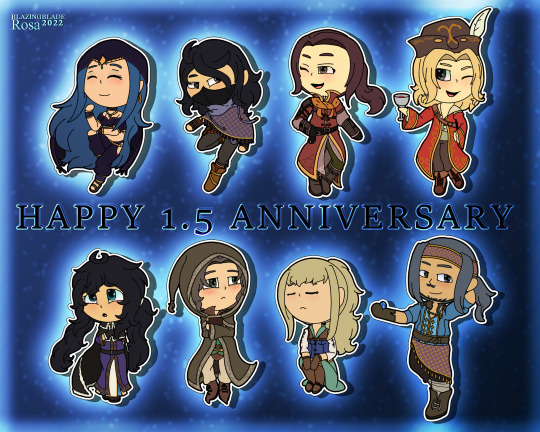
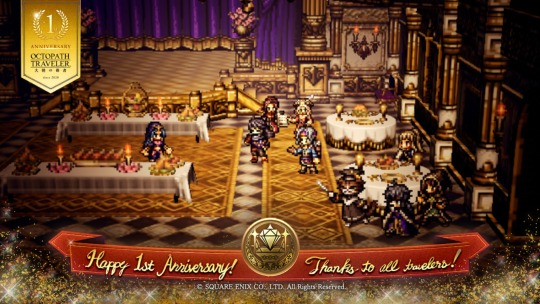
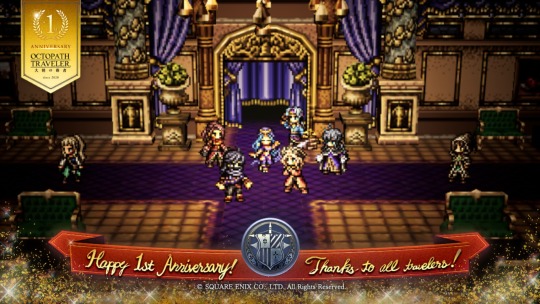
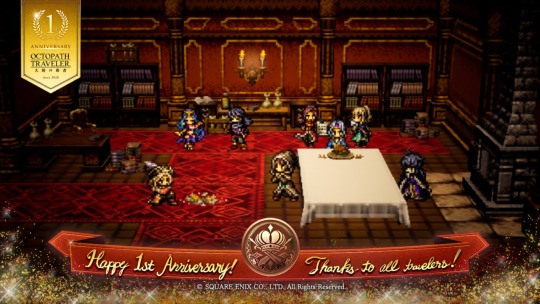
The dynamics of my team are: - Iris and Wingate are a couple, they support each other with their troubles and met in Theatropolis during his Traveler Story. - Wingate and Brigitte are brother and sister (not canon, simply a headcanon), while Gilderoy treats them as his kids, but he's not exactly suited as a father figure, he still tries to be the "fun dad". - Lyummis and Gilderoy act a bit like a "old married couple" sometimes, she doesn't approve of a lot he does though since he is very childish for his age. She often cleans up his messes. - Levan and Brigitte are best friends, they also have a bit of a crush on each other, but none dare say so. (They will later! For now, let kids be kids!) - Iris helps Brigitte be a bit more confident with herself. Lyummis also treats Levan as the little brother she never had. She feels protective over him. Both kids appreciate the support from someone older. - Narr and Durand are friends. Though they are friends, Durand doesn't like Narr's attitude much, especially when he is drunk (Narr's an angry drunk while Durand is a happy one). Note: They belong more to the "Barrad's Group" my brother and I have put together! It consists of Barrad, Durand, Dorothea, Narr, Cecily, Ned, Eltrics, and Leon. Here's a picture of a few of the playable ones + Ned!
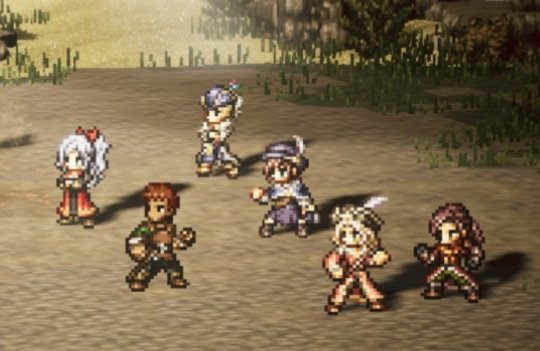
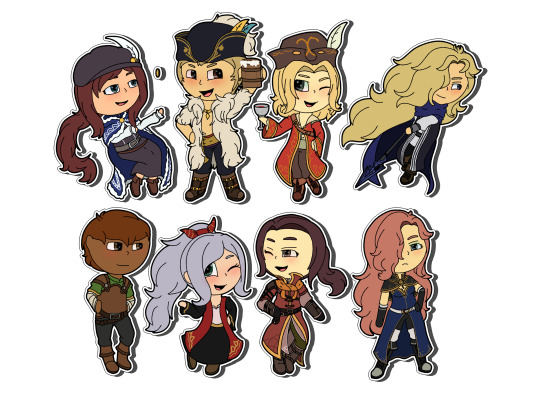
This group consists of lots of merchants or other business people, as well as lots of people that long for freedom or adventure! They are a lot of seafarers too, so maybe one day they can all take a trip together! Barrad and Dorothea are a couple. Leon and Eltrics are good friends, he's one of the few people that can make her smile). As for the dynamic with Narr and Cecily... Cecily mentions a "her scribe" in Olberic's chapter 2, I like to think Narr got a job working with her as he's a skilled contract maker. Brigitte and Levan also have a group of friends! I call it the "Kid Group" for lack of a better name. It features Brigitte, Levan, Molrusso, Lolo & Rulu, Dorrie, Harry, Titi, Largo, and Zegna! The theme these kids have is special talents or social awkwardness (which is not a bad thing!!). They all support each other like a group of friends should. Titi's a lot more confident than the rest of them, so she wants to help them all be comfortable with themselves and putting themselves out there! She also loves to dance with Harry! While Levan and Dorrie are book nerds. Zegna and Molrusso join them too! Lolo keeps to himself (he's the protector of the mountains, he's cautious around people) and Rulu mostly, but he joins in conversations sometimes as well. Largo also gets along with the ones that like books as an inventor he's always looking for new ideas for projects!

Like, you can have so much fun constructing a perfect team! So have fun with CotC and enjoy the game for whatever reason! I want to see your teams and their dynamics one day!
5 notes
·
View notes
Text
ever since I wrote that fic where it’s old!Percy rejoining his friends in the afterlife, I wanted to drop some of my other future!TTP headcanons
If s1 happens at 0 CGK (cute gay kiss), the fic took place at 87 CGK (or roughly when Percy Jr. is ~100
Electricity is introduced and commodified in universe around 60 CGK because I say so. Miss me with “medival ages and shit” there exists a grainy weathered photo of the TTP Gang in old age together inbetween the pages of one of Wens’s books.
Speaking of Wensclaus, he takes over the throne in his early twenties. Not because anything happens to Amir or Rupert, but because they set a precedence of turning over the throne to the next generation as an extension of this continued dismantlement of absolute power.
I headcanon that adult! Wensclaus never marries, he’s aro/ace. He, however, forms a gang similar to that of his fathers’ consisting of the Southern royal twins, Joan and Cecily’s son, Darling and Percy’s son, and the fairy queen’s daughter. Together they fight a multitude of evils and do so in style.
Eventually, Wensclaus takes on a mentee from the Hinterlands. Their name is Law, a non-binary goat farmer who Wensclaus eventually adopts. It’s really cute trust me- it’s all about the found family trope. They ascend to the throne in their mid-twenties similar to Wensclaus. Rupert goes overboard with being a grandfather. Amir tries to real him in, but “this time it’s practical, Rupert! They mentioned they liked reading, so I had every one of our histories and scientific journals transcribed and sent to their castle!”
Darling and Percy get together long after the events of season three, when Darling’s youth has subsided and Percy’s ambition has mellowed. With gray hairs and new humility, they learn to bring out in the best in each other. Cecily like, totally ships it.
Cecily also pioneered electricity alongisde the southern princess. (what, like it’s hard?). The first electrical circuit to power a light bulb is named the Cecilian Circuit.
Out of all their friends, Rupert is the first to die. There’s some poetic metaphor there about how the character who starts it all is the first to leave; but it’s well past midnight so I won’t get too into it. It’s of natural causes, of course, but it doesn’t lessen the blow to Amir. People from the East, west, north and south travel miles and miles for the funeral. It’s said the city was clothed in black. That day a great golden statue of the two former Kings is ordered by Monarch Law for the center square of the heartlands. In secret, however, they also request a marble statue be discreetly installed in the former hollow, which was about a day’s ride from the bustling city. They have it blessed by the fairy queen, so that it may last indefinitely. Amir visits it often.
Joan is the next to leave. She was a good two decades into retirement, but her good friend, the southern queen, requested aid against a sorcerer from a nation across the waters. Joan sacrificed herself and saved countless lives. For weeks, the royal guard wore black to celebrate their fallen commander.
Darling, Amir, Cecily, and Percy Jr. live long into old age. Darling meets his granddaughter, Lavinia, shortly before he leaves. Cecily spends endless days constructing intricate gardens using Joan’s pensions. When she passes, they are made into the first national park. Amir passes just a week before Percy- when the fic I referenced earlier occurs, Percy is returning from the funeral. Amir’s final words to Percy were promises that “Don’t be afraid, Percy. We’ll see you again soon.”
On 87 CGK, Percy discovers Amir is right. Reunited with his family, he sets off for the next great adventure.
#the two princes#the two princes podcast#ttp#prince rupert#prince amir#rumir#ttpp#ttp podcast#prince darling the two princes#lady cecilly ttp#sir percy jr ttp#sir joan ttp#Wensclaus ttp
54 notes
·
View notes
Text

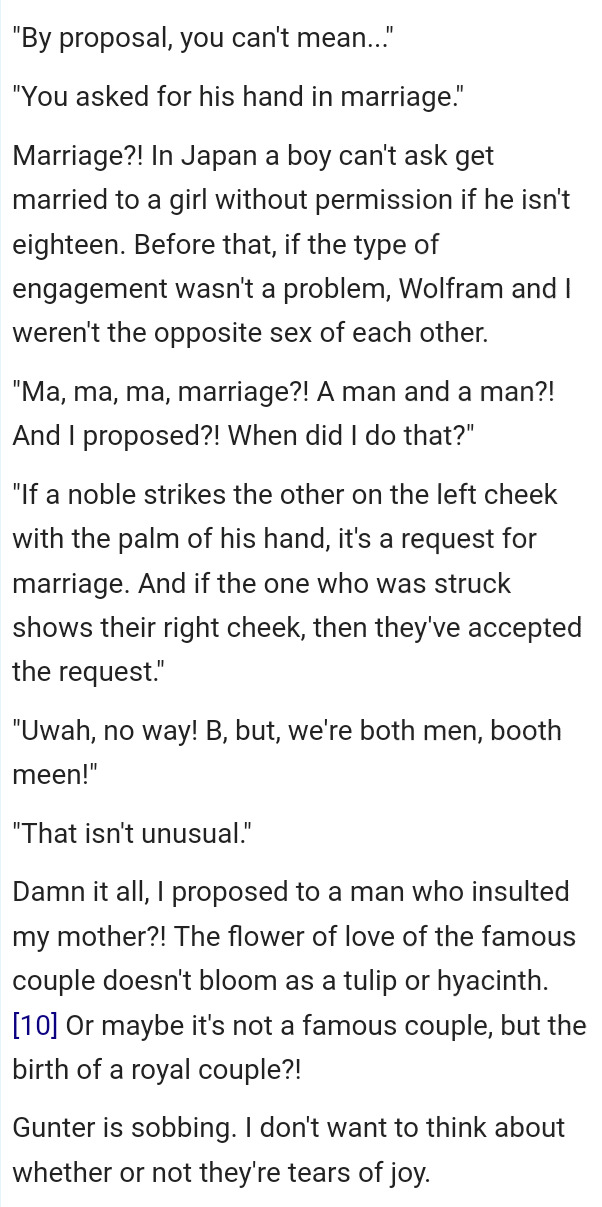
How the Royal Couple came to be-
Since I really didn't have anything to share yet (cause my fic is making me sweat buckets) so I thought I could share this awesome part of how our Royal Couple were engaged. It is so amazingly written that every line makes me laugh and hold a different emotion.
You feel it more once you thoroughly know all the novel characters, or have travelled with them through some part of the 17 volume long adventure. It is a wonderful and tender feeling, when you know how they'd grow from this point on. And develop because of a misunderstanding of all things!All you need is a quick read of chapter 4 of volume 1 and you find so much.
Conrart's years of wait and his mission when he assures Wolfram that he can never mistake Yuuri.
Gwendal's years of dedication and calm care when he accepts Yuuri but had increased frown lines when he concluded that Yuuri didn't want to be a Maou- knowing him it was probably his way of taking care of him, probably indirectly saying "You don't need to burden yourself with something you don't want to do".
We also see Wolfram's judgement, as even though he was annoyed but he had his reasons because he didn't want to witness this country go through another war. All he wanted was a ruler who loved this country and he'd serve him gladly. Thankfully he did get one.
We see the forshadowing of Julia's soul when Yuuri mentions he can always know when Conrart is smiling.
We see a Günter in the initial stage of becoming Heika fanatic and spilling juices all around.
We see Cecilie's love for her children, and her husbands. Their unique but endearing mother-son bond.
We see the acceptance of homosexuality as another form of love. Because, love is free to pursue!- in Lady Cheri's words.
We also witness Shin Makoku's culture, it's delicacies and know how different it is just as much as it is similar. (Admit it, we are all secretly glad for Yuuri's clumsiness- and him not wanting to punch the beautiful face🤣)
All of this woven humorously, just like how Takabayashi-sensei does. And, I realise, yet again, just how much this novel means to me.
#kkm#maruma#kyou kara maou#yuuram#kyo kara maoh#yuuri shibuya#wolfram von bielefelt#conrart weller#gwendal von voltaire#gunter von christ#cecilie von spitzberg#I forgot the spelling so spare me#my ramblings of kkm novel cause i love it too much#MAnniversary 2020#MA event
38 notes
·
View notes
Text
The Cabinets of Barnaby Mayne - Elsa Hart

Summary: London, 1703: Lady Cecily Kay returns to England to visit the famous collection of Barnaby Mayne. She becomes distracted in her identification of botanical samples when her host is found murdered.
Quote: “Mayne has spent forty years funding travelers and having their briny crates delivered to him from as near as France and as far as China. He knows which letters to write, which parties to attend, which societies to join, and which monographs to debate. He has played the game, Babington, and he has played it for a long time. I cannot help but admire the old obsessive.”
My rating: 3.0/5.0 Goodreads: 3.63/5.0
Review: There’s nothing technically wrong with the book. The mystery is well-crafted, there’s a good mixture of adventure and methodical detective work, and it was a nice change of pace to have a historical mystery that forefronts two women. Indeed, Cecily and Maecan’s buddy-cop energy is one the highlights of the book. Unfortunately, the rest of the book never really feels alive. The historical time period feels like a prop and the tone is distinctly contemporary. Cecily’s drive to solve the mystery is the only real urgency to it. No one seems much to care what happened to Mayne and the man unjustly accused of his murder often fades in the background. It was satisfying enough that I might consider picking up the sequel—the ending provides a clear set-up for one—but only as background listening for work. The audiobook, read by Barrie Kreinik, is well-done.
2 notes
·
View notes